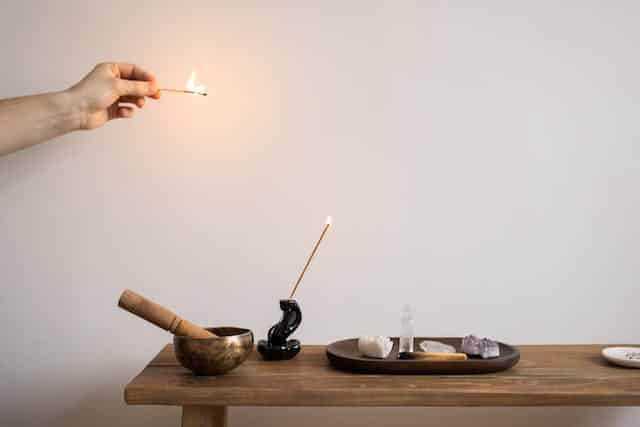
Incense, with its enthralling scents and smoke, has been an integral part of cultural and spiritual rituals for centuries, traversing borders and civilizations.
The act of burning incense, whether it be the gentle glow of incense sticks or the more intense aroma of resin, has a profound ability to transform spaces with its rich incense scents.
This blog aims to delve into all the incense types and their unique aromatic ingredients, offering a fragrant journey through the ages and across continents.
So, hop on as we dive deep into the world of incense.
Understanding Incense

Incense, a symbol of tradition and tranquillity, manifests in various forms, each carrying a unique essence and a ritual of burning. The most familiar forms are incense sticks and incense cones, known for their ease of use and the gentle, persistent fragrance they release.
Burning incense, a practice deep-rooted in history serves not just as a means to fragrance a space but as a bridge to a more meditative, reflective state of mind.
Incense burning, regardless of the form, is a practice steeped in cultural significance. Across continents, whether it’s the slow burn of an incense stick in an Asian temple or the rich scent of a frankincense-infused church in the Middle East, the act transcends mere fragrance.
It’s a communal language, a shared experience that speaks of heritage, spirituality, and the human connection to nature.
Moreover, the versatility of incense sticks and incense cones allows them to be integral to various rituals and daily routines. The act of lighting an incense stick or cone can signify the beginning of a meditation session, mark the start of a religious ceremony, or simply denote the desire to create a tranquil space.
In understanding incense, one recognises it as more than just a sensory delight. It’s a thread that weaves through histories and cultures, a simple yet profound element that transforms spaces, elevates moods, and connects us to a richer, more aromatic world.
As we embrace the traditions of incense burning, we partake in a legacy that has been cherished and preserved over centuries, carrying forward the timeless allure of incense sticks and incense cones into our modern lives.
Understanding Incense Sticks
Incense sticks, slender and coated with aromatic compounds, are perhaps the most widespread form of incense. The simplicity of lighting an incense stick and the slow, steady release of scent make them a favourite in households and sacred spaces alike. The artistry behind incense sticks is evident in their composition – a careful blend of natural ingredients bound together, ready to awaken the senses as they smoulder.
Understanding Incense Cones
In contrast, incense cones offer a more intense experience. Shaped into small pyramids, incense cones burn relatively quicker than incense sticks, releasing a more concentrated aroma that can swiftly fill a space with its character.
The ritual of burning incense cones is therapeutic, often used in aromatherapy to harness the benefits of essential oils and herbs, thus creating an ambience that fosters relaxation and well-being.
Diverse Incense Types and Their Origins

The tradition of burning incense is as varied and rich as the cultures that embrace it. Each region of the world adds its unique touch to this ancient practice, infusing it with local herbs, resins, and methods that tell a story of heritage and tradition.
When you burn incense, it is not just about scent; it’s a ritual, a time-honoured tradition that connects the present to the past.
India
In the vibrant subcontinent of India, Ayurvedic blends of incense are not just for fragrance; they are a holistic approach to well-being. Herbs and spices are carefully picked for their healing properties and combined in precise proportions to align with spiritual practices and promote physical and mental health. When one burns incense in this tradition, it’s an act of purification and an invitation to tranquillity.
Japan, China, and Korea
Moving eastward, the meticulous craft of incense in countries like Japan, China, and Korea reflects a meditative connection to scent, deeply intertwined with rituals and ceremonies. The practice of indirect burning incense, where the incense does not directly touch the flame, allows for a subtler release of fragrance.
This method, often involving an incense burner and charcoal, speaks to the contemplative nature of these cultures, where every element of the incense burning process is a step in a meditative journey.
Middle East and Africa
In the Middle East and Africa, the burning of resinous incense like frankincense and myrrh is a practice laden with historical and religious significance. These resins, treasured since ancient times, are often used in their pure form.
Put on hot coals in an incense burner, they release a rich, deep fragrance that is integral to religious rituals and has been revered for its supposed healing properties.
West
Meanwhile, in the West, a modern take on this ancient practice sees traditional elements being fused with contemporary preferences. The desire to burn incense has led to the creation of blends that cater to modern sensibilities while maintaining the essence of the ritual.
Indirect burning incense methods, popular in Eastern traditions, have also found a place in Western practices, allowing for a more controlled and subtle scent experience.
The global tapestry of incense types and their origins is a testament to the universal human desire to elevate the senses, connect with the divine, and find peace in the ritual of burning incense.
No matter which area, the tradition of incense burning remains a deeply ingrained and cherished practice. It’s a ritual that transcends geographical boundaries, uniting us in our shared love for the transcendent and the sublime.
Aromatic Ingredients in Incense

The allure of incense, be it coil incense, powder incense, or stick incense, lies not just in its ability to perfume a space but in its capacity to evoke memories, emotions, and even a sense of the sacred. The essence of incense comes from a symphony of aromatic ingredients, each playing a vital role in crafting the unique character of different types of incense.
Coil incense, with its long-lasting burn time, is renowned for its continuous, enveloping fragrance. Originating in East Asia, this type of incense is often used in temples and during extensive ceremonies. The ingredients in coil incense are meticulously chosen to create a scent that can sustain and permeate through large spaces, wrapping the surroundings in a delicate, persistent aroma.
Powder incense offers a more versatile approach to scenting an environment. Users can burn powder incense on its own or mix it to create custom scents.
The purity of the aromatic ingredients in powder incense is paramount, as it directly affects the subtlety and richness of the fragrance it produces. It’s a type of incense for the connoisseur, one who understands and appreciates the art of blending and the nuances of fragrance.
Stick incense is perhaps the most ubiquitous of all types of incense. It’s simple, portable, and comes in an almost infinite variety of scents. The core of stick incense is often made from a thin bamboo stick coated with a blend of natural ingredients like resins, essential oils, and herbs.
Stick incense is beloved for its ease of use and the purity of its scent – a direct result of the aromatic ingredients that smoulder as the incense burns.
When discussing types of incense, the focus naturally shifts to the aromatic ingredients that define their essence. Resins like Frankincense and Myrrh are celebrated for their rich, deep scents – woody and citrusy in the case of Frankincense, warm and slightly bitter for Myrrh. These resins have been used for millennia, not just for their fragrance but for their purported spiritual and healing properties.
Essential oils are another cornerstone of incense’s aromatic profile. Extracted from flowers, fruits, and leaves, these oils are pivotal in defining an incense’s character. The versatility of essential oils is immense, ranging from the soothing calm of lavender to the zesty energy of citrus, allowing for a wide spectrum of scents in different types of incense.
Lastly, herbs and woods lend their natural aromas to incense, grounding it with earthy, robust notes. The cultural backdrop of these ingredients is often what influences their use in certain types of incense. For example, sandalwood, with its rich, woody scent, is a staple in many Asian incense formulas, while sage is commonly used in Native American smudging ceremonies.
In New Zealand, where the appreciation for natural, pure products is prominent, the quality and sourcing of these aromatic ingredients are of paramount importance. The types of incense chosen by Kiwis often reflect a keen awareness of environmental and ethical considerations, echoing the country’s deep connection to nature and commitment to sustainability. You can explore the wide variety of incense burners and holders in NZ.
Crafting Scents – The Art of Incense Making

The creation of incense is a craft honed over centuries, a delicate balance of artistry and science. It’s a process that requires a deep understanding of the materials involved, an appreciation for tradition, and a keen sense of creativity.
The art of incense making involves more than just mixing ingredients; it’s about capturing a story, an emotion, and a memory within the pleasant aroma that incense releases as it burns.
Direct burning incense is the most common form of incense found across the globe. It’s designed to be lit directly by a flame and then fanned or blown out, allowing it to smoulder and release its fragrance.
The creation of direct burning incense involves a meticulous process of blending natural ingredients like herbs, resins, and essential oils. The mixture is then bound together, often with a natural gum or resin, ensuring that the incense burns steadily and consistently, releasing the pleasant aroma crafted by its maker.
In New Zealand, where the appreciation for the world is deeply embedded in the culture, incense makers often draw inspiration from the local flora to create scents that are unique to the region. They understand that the heart of incense lies in its ability to transport the individual, through scent, to a place of peace and tranquillity.
This understanding is reflected in the careful selection of ingredients, ensuring that they not only produce a pleasant aroma but also embody the natural beauty and purity of the country.
Incense burners are an integral part of the incense experience. They are not only functional items but works of art in their own right, often crafted to reflect the cultural and spiritual significance of incense burn. In many cultures, the incense burner is considered a sacred object, and much thought is put into its design and placement within the home or place of worship.
Modern techniques in incense making have introduced innovative twists to the age-old practice, broadening the aromatic spectrum while honouring the incense’s ancient roots. These techniques have allowed incense makers to experiment with new scent combinations, creating fragrances that cater to contemporary preferences while maintaining the soulful essence of traditional incense.
The process of making direct burning incense, with its intricate blending of natural ingredients, reflects a deep respect for nature and tradition. It’s a practice that requires patience, precision, and a profound understanding of the interplay between different elements.
The result is not just an incense stick or cone but a sensory experience that can calm the mind, uplift the spirit, and transform the ambience of a space.
The Therapeutic Effects of Aromatic Ingredients

Incense, with its fragrant smoke and rich heritage, has transcended its cultural roots to become a cherished component in the realm of holistic wellness. The aromatic ingredients used in incense are not just about creating a pleasant scent; they play a pivotal role in aromatherapy, where the power of fragrance is harnessed to enhance emotional and mental well-being.
Aromatherapy and Incense: A Scented Path to Well-being
Aromatherapy, an age-old practice, involves using natural plant extracts to promote health and well-being. Cone incense and stick incense, with their concentrated fragrances, are particularly effective in this practice.
As the incense burns, the fragrant smoke carries the essence of the incense mixtures, each ingredient carefully chosen for its specific therapeutic properties. The scents released by incense can trigger responses in the brain that affect mood, stress levels, and even hormone balance, making aromatherapy a powerful tool for mental and emotional equilibrium.
Cone Incense: Intensity and Intention
Cone incense, known for its intense and rich aroma, is often used in aromatherapy for more focused sessions. The shape of the cone allows for a more concentrated burn, creating a potent fragrant smoke that fills the space quickly.
This intensity makes cone incense ideal for shorter, more intentional therapeutic sessions where a stronger scent is beneficial, such as in practices aimed at reducing stress or enhancing focus.
Cleansing Spaces: The Role of Incense Burner Ash
The use of incense in cleansing and purifying spaces is another aspect of its therapeutic properties. The incense burner ash, a byproduct of the burning process, is often seen as a symbol of the cleansing that has occurred.
In many traditions, the accumulation of ash is a sign of the space being purified and renewed, with the old energies being replaced by the new, more harmonious ones brought in by the incense’s aroma.
Balancing the Mind: The Subtle Power of Incense
The subtle power of incense lies in its ability to balance the mind. Different scents can have varying effects – some can be uplifting and invigorating, while others might be calming and grounding. This balancing act is at the heart of incense’s therapeutic use.
By selecting the appropriate incense for one’s current needs, it’s possible to create an environment that supports a desired emotional or mental state.
Sustainable Practices in Incense Production

In today’s world, where the consciousness about our environmental footprint is ever-increasing, the incense industry is stepping up to embrace sustainability as a core principle.
The journey of incense, from its production to its final aromatic release in an incense holder, is being redefined through practices that prioritize the well-being of the planet and its inhabitants.
Ethical sourcing, eco-friendly production methods, and fair trade practices are not just buzzwords but essential components of a sustainable incense industry.
Ethical Sourcing: Respecting Nature’s Gifts
The first step towards sustainability in incense production is ethical sourcing of raw materials. This means ensuring that the herbs, resins, and essential oils used in incense mixtures are harvested responsibly.
The harvesting should not deplete natural resources or harm the environment. By respecting the ecosystems from which these aromatic ingredients are sourced, producers can help preserve biodiversity and the natural balance.
Moreover, ethical sourcing also involves fair compensation and good working conditions for the growers and harvesters, ensuring that the benefits of incense production reach everyone involved in the process.
Eco-Friendly Production Methods: A Clean Burn
Sustainable practices in incense production also extend to the manufacturing process. Producers are increasingly adopting eco-friendly methods that minimize waste and reduce their carbon footprint. This includes using renewable energy sources, recycling water, and ensuring that packaging is biodegradable or recyclable.
Additionally, producers are focusing on creating incense that burns cleanly, reducing indoor air pollution and ensuring that the wafting fragrant smoke is not only pleasant but also safe for the environment and the people in it.
Fair Trade: Supporting Communities
Fair trade is another cornerstone of sustainable incense production. This involves ensuring that the artisans and workers involved in crafting the incense are paid fairly and work under safe conditions.
Fair trade practices help uplift communities and provide them with the means to thrive while preserving their traditional crafts. By choosing incense from brands that adhere to fair trade principles, consumers can contribute to a more equitable and just global trade system.
Safe Use and Disposal: The Responsibility of the User
Sustainability in the world of incense also involves responsible use and disposal. Consumers are encouraged to use incense holders to catch ash and to never leave burning incense unattended, ensuring safety and preventing accidental fires.
Proper disposal of incense ash and remnants is also crucial. By disposing of incense residue responsibly, users can prevent pollution and contribute to the overall sustainability of the incense journey.
Conclusion

Incense, with its rich variety and profound cultural roots, offers more than just a scent; it’s an experience, a journey through time and tradition.
As we explore different incense types and their aromatic ingredients, we partake in a global heritage, one that respects the past and embraces the future.

